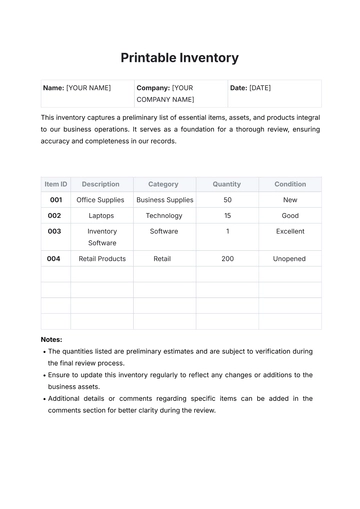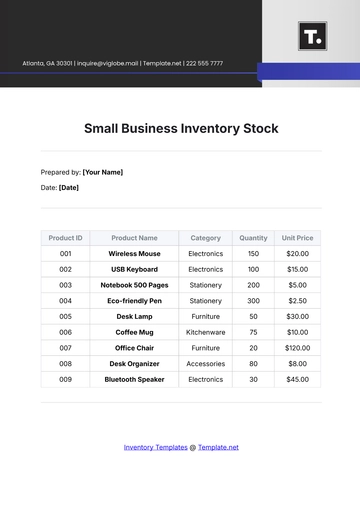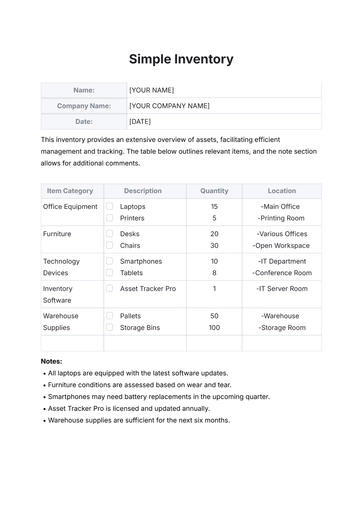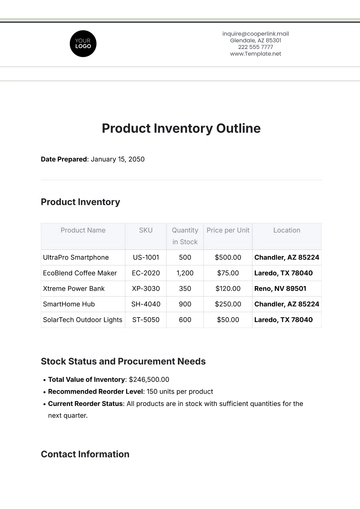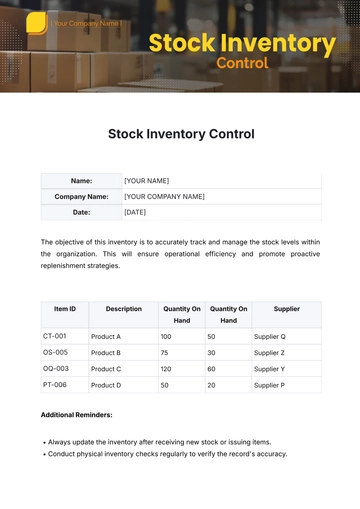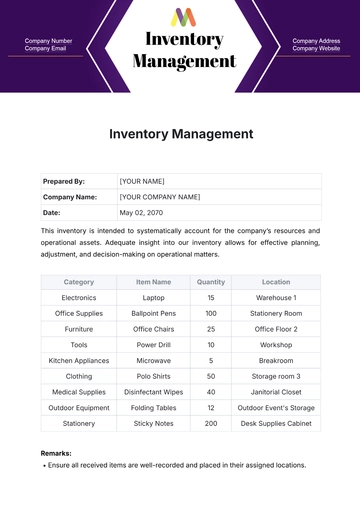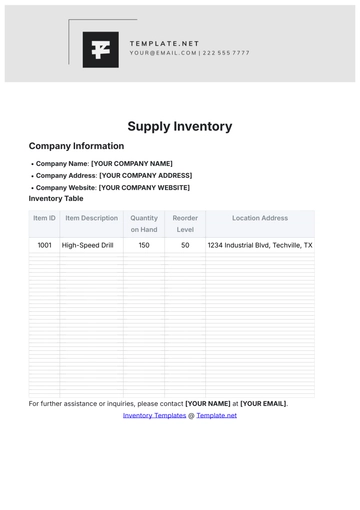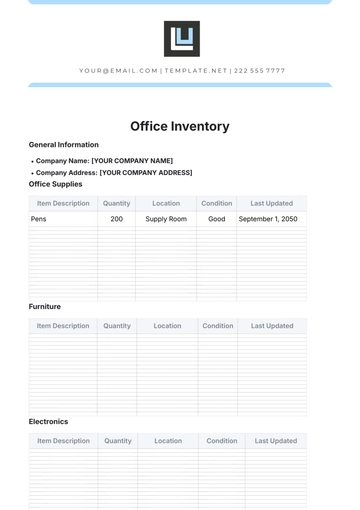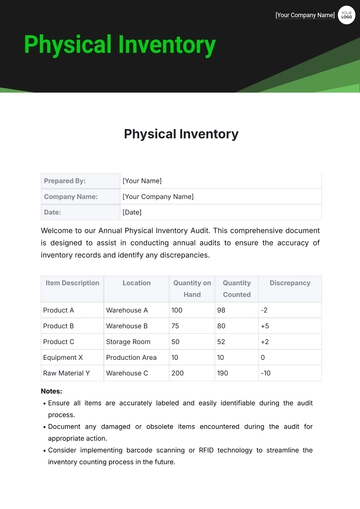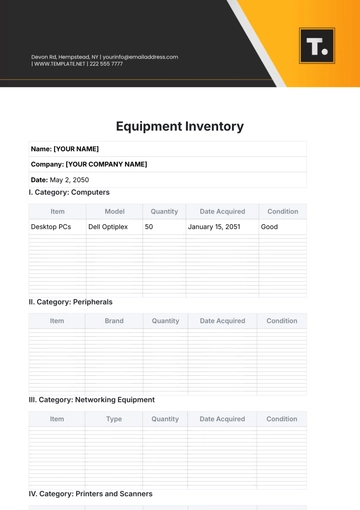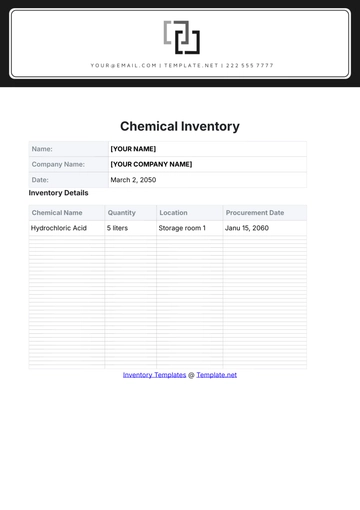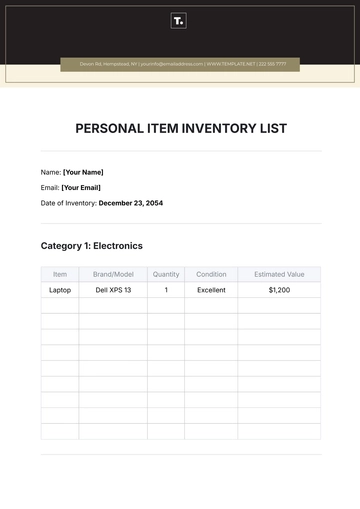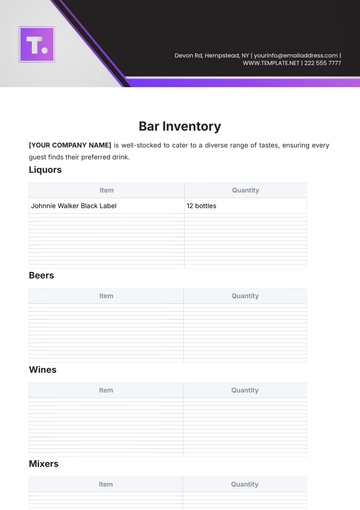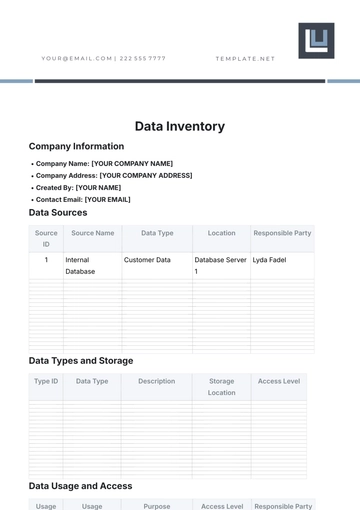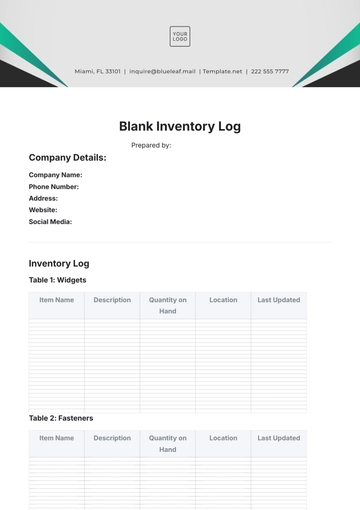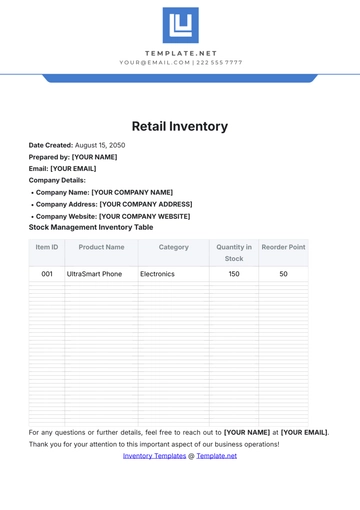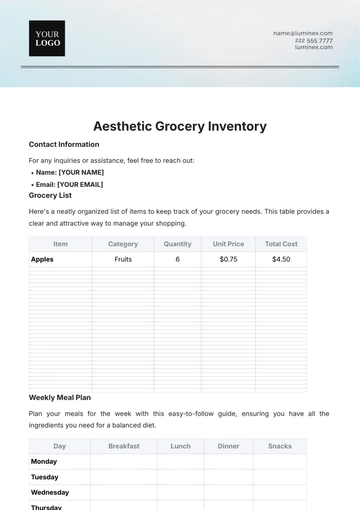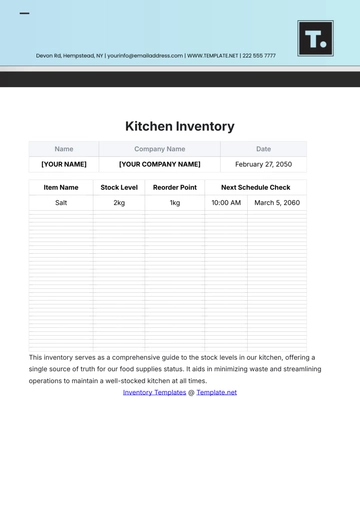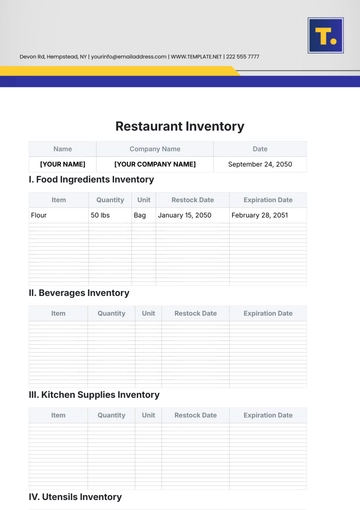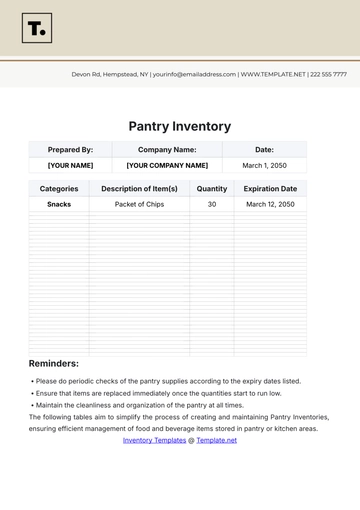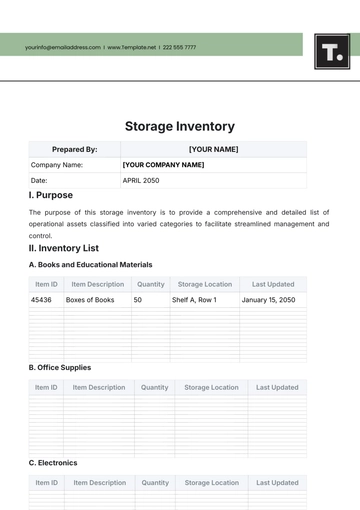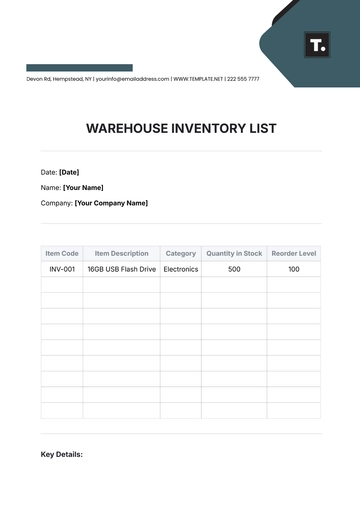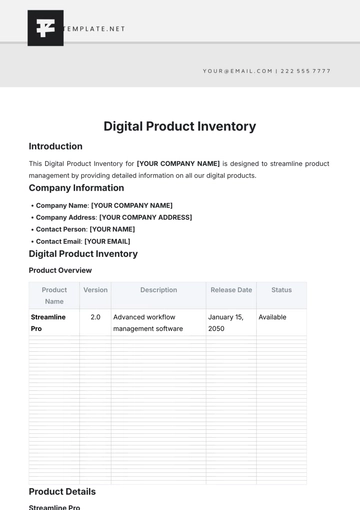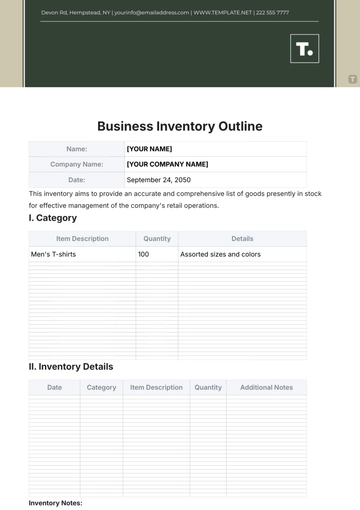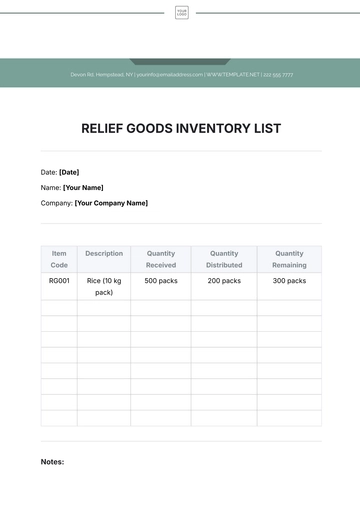Free Salon Inventory Report
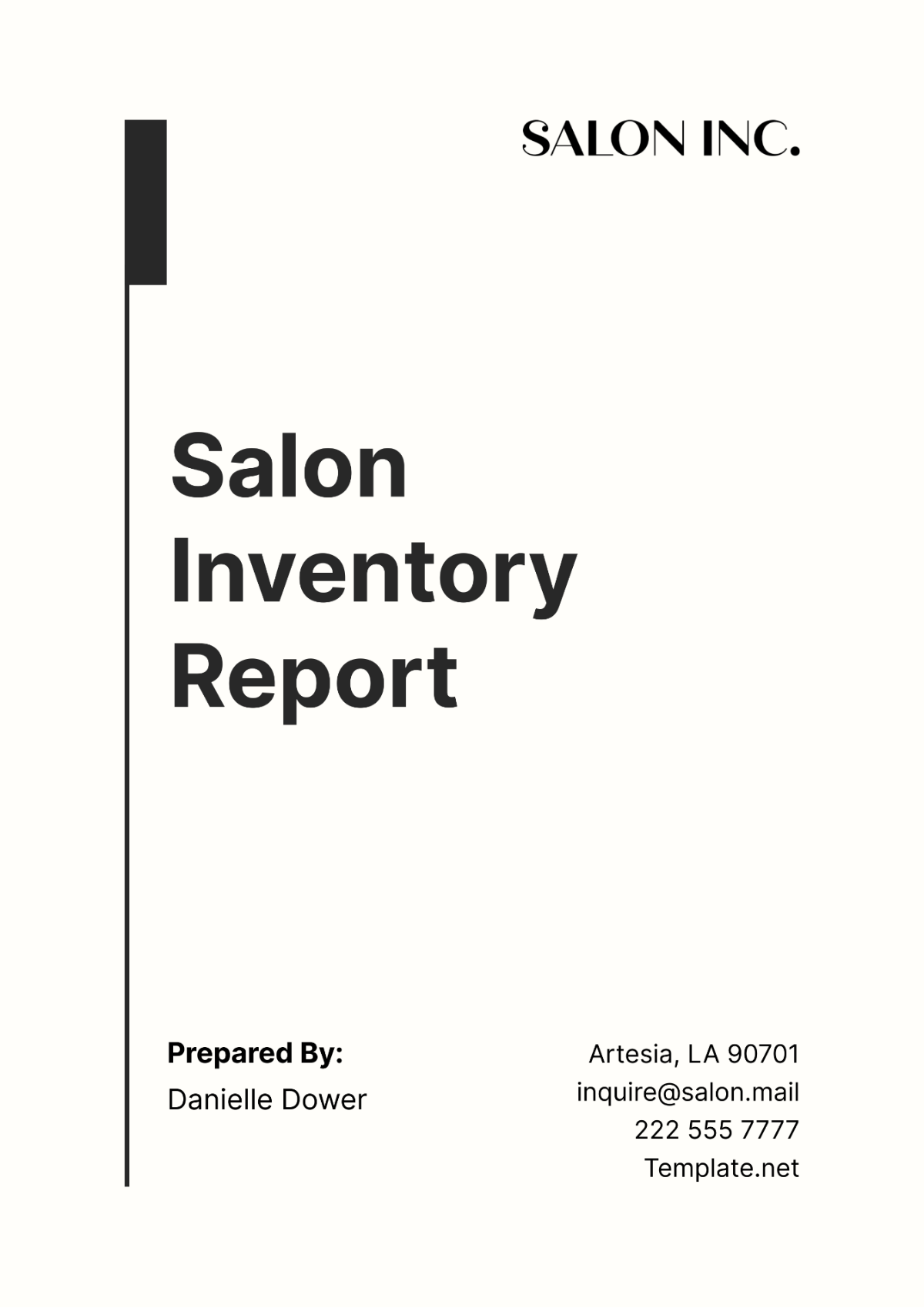
I. Introduction
A. Purpose of the Report
Comprehensive Overview: The primary purpose of this report is to provide a comprehensive overview of the current state of inventory at [Your Company Name]. This includes the quantity and value of each item in stock. By having a clear understanding of what is in stock, the salon can better manage its resources, avoid overstocking or understocking, and ensure that the needs of the customers are always met.
Inventory Movement Analysis: The report also aims to analyze the movement of inventory items. By identifying fast-moving, slow-moving, and non-moving items, the salon can make informed decisions about reordering, promotions, and disposal of items.
Recommendations: Lastly, the report seeks to offer recommendations based on the analysis. These recommendations aim to improve inventory management, reduce carrying costs, and increase turnover rate. By implementing these recommendations, the salon can optimize its operations and maximize profitability.
B. Inventory Management Team
Team Lead: The inventory management team is led by the Inventory Manager. The Inventory Manager oversees the entire inventory process, ensuring accuracy and efficiency. They are responsible for planning, coordinating, and controlling the inventory from purchase until it has been used or sold.
Team Members: The team comprises of several Inventory Clerks. The Inventory Clerks are responsible for counting and recording the inventory items. They ensure that the physical count matches the count recorded in the inventory system. Their meticulous work is crucial in maintaining accurate inventory records.
Auditors: The team also includes Internal Auditors. The Internal Auditors verify the accuracy of the inventory count and the report. They provide an additional layer of assurance that the inventory records are accurate and reliable.
C. Date of Inventory
Inventory Year: The inventory was conducted in the year 2050. Conducting an annual inventory is a standard practice that helps the salon keep its inventory records accurate and up-to-date.
Frequency: [Your Company Name] conducts a full inventory count annually. This practice ensures accurate accounting and efficient management of stock. It also helps the salon identify any issues or discrepancies early and take corrective action.
Next Inventory Date: The next inventory count is scheduled for the year 2051. Regular inventory counts are crucial in maintaining an efficient inventory management system.
II. Inventory Overview
The inventory overview provides a snapshot of the salon’s inventory status. It includes key metrics such as the total inventory value, the inventory turnover rate, and the inventory carrying cost. The following table presents these metrics:
Metric | Value |
|---|---|
Total Inventory Value | $5,240 |
Inventory Turnover Rate | 5 times/year |
Inventory Carrying Cost | $2,000/year |
A. Total Inventory Value
The total inventory value is the sum of the cost of all items currently in the salon’s inventory. As of the date of this report, the total inventory value is $5,240. This value represents the total investment the salon has made in its inventory. It’s important to monitor this value to ensure that the salon is not over-investing in inventory, which could lead to high carrying costs and potential losses due to obsolescence or shrinkage.
B. Inventory Turnover Rate
The inventory turnover rate is a measure of how many times the salon sells through its inventory in a year. A higher turnover rate indicates that the salon is selling its inventory quickly, which is generally a positive sign. However, a very high turnover rate could indicate that the salon is frequently running out of stock and potentially missing sales opportunities. The current inventory turnover rate is 5 times/year.
C. Inventory Carrying Cost
The inventory carrying cost is the cost associated with holding inventory. It includes costs such as storage, insurance, and potential losses due to obsolescence or shrinkage. The salon’s current inventory carrying cost is $2,000/year. It’s important to minimize this cost as much as possible, as it directly impacts the salon’s profitability.
Understanding these metrics is crucial for effective inventory management. They provide insights into [Your Company Name]’s inventory efficiency and profitability. By monitoring these metrics, the salon can make informed decisions about purchasing, storing, and selling inventory items.
Moreover, these metrics also have broader implications. For example, a high inventory turnover rate could indicate strong sales, which might suggest that the salon could afford to invest in expanding its product range or improving its facilities. On the other hand, a high carrying cost might indicate that the salon needs to improve its inventory management practices or negotiate better terms with its suppliers.
III. Detailed Inventory
A. Hair Care Products
Hair care products are essential in any salon. They play a crucial role in providing services that keep clients’ hair healthy and stylish. The following table presents a detailed breakdown of the hair care products in the salon’s inventory:
Product | Quantity | Unit Price | Total Value |
|---|---|---|---|
Shampoo | 50 | $10 | $500 |
Conditioner | 60 | $12 | $720 |
Hair Color | 40 | $15 | $600 |
Hair Spray | 30 | $8 | $240 |
Hair Gel | 20 | $9 | $180 |
Hair Mousse | 25 | $10 | $250 |
Hair Serum | 15 | $14 | $210 |
Hair Mask | 10 | $16 | $160 |
Total | $2,600 |
The hair care products category shows a diverse range of products. The quantity and total value of each product indicate the salon’s investment in each type of product. For instance, the salon has a significant investment in shampoos and conditioners, which are essential for most hair care services. On the other hand, the salon has a smaller investment in hair masks, which might be used less frequently or for specific services.
The unit price of each product can also provide insights into the salon’s pricing strategy. For example, the higher unit price of hair serums and hair masks suggests that these are premium products. The salon might be offering high-end services that use these products, or it might be selling these products to customers for home use. Either way, these products could be significant contributors to the salon’s revenue.
B. Skin Care Products
Skin care products are vital for a salon offering comprehensive beauty services. They help clients maintain healthy and glowing skin. The following table presents a detailed breakdown of the skin care products in the salon’s inventory:
Product | Quantity | Unit Price | Total Value |
|---|---|---|---|
Cleanser | 45 | $12 | $540 |
Toner | 40 | $10 | $400 |
Moisturizer | 50 | $15 | $750 |
Face Mask | 30 | $8 | $240 |
Exfoliator | 20 | $10 | $200 |
Serum | 25 | $18 | $450 |
Eye Cream | 15 | $20 | $300 |
Sunscreen | 35 | $14 | $490 |
Total | $2,120 |
The assortment of skin care products illustrates a diverse range of items, reflecting the salon's investment across different product types based on their usage and importance. For example, a substantial amount of capital is allocated to essential items like cleansers and moisturizers, central to numerous skin care treatments, whereas a lesser investment is made in eye creams, likely due to their occasional use or specialized application.
Analyzing the unit price of each item, such as serums and eye creams, reveals the salon's pricing strategy; their higher costs indicate they are considered luxury items. This suggests that the salon either incorporates these premium products into upscale services or sells them directly for client home care, potentially making them major revenue sources.
C. Nail Care Products
Nail care products are indispensable for a salon offering manicure and pedicure services. They contribute to the overall beauty experience of the clients. The following table presents a detailed breakdown of the nail care products in the salon’s inventory:
Product | Quantity | Unit Price | Total Value |
|---|---|---|---|
Nail Polish | 60 | $5 | $300 |
Base Coat | 30 | $6 | $180 |
Top Coat | 30 | $6 | $180 |
Nail Hardener | 20 | $7 | $140 |
Cuticle Oil | 25 | $8 | $200 |
Nail Polish Remover | 40 | $4 | $160 |
Nail File | 50 | $2 | $100 |
Nail Buffer | 50 | $2 | $100 |
Total | $1,080 |
The range of nail care items showcases a varied collection, where the quantity and total value of each type demonstrate the salon's approach to different product categories. For instance, there's a significant investment in nail polishes, essential for many nail treatments, while nail hardeners see a smaller investment, probably because they are used less often or for more specific purposes.
Analyzing the unit price of individual products, such as the elevated cost of cuticle oil, indicates its status as a premium item and can shed light on the salon's pricing approach. This suggests the salon could either be targeting high-end service provisions utilizing the oil which might significantly enhance the salon’s financial earnings.
IV. Inventory Analysis
A. Fast-Moving Items
Shampoo: Shampoo, being a staple in our hair care services, moves quickly off our shelves. Its high demand necessitates frequent reordering to maintain an adequate stock. This ensures that we can continue to provide high-quality hair care services to our clients without any interruptions.
Conditioner: Conditioner follows closely behind shampoo in terms of demand. Monitoring stock levels is crucial to prevent running out of this popular item. Regular stock checks and timely reordering can help us maintain a steady supply and meet our clients’ needs effectively.
Moisturizer: In the realm of skin care, moisturizer leads the pack. Its high turnover rate calls for a well-planned reordering strategy. By keeping a close eye on its stock levels and demand patterns, we can ensure that we always have enough moisturizer on hand to cater to our clients’ skin care needs.
Nail Polish: Nail polish, a star in our nail care services, is another fast mover. Keeping a close eye on its stock levels can help us avoid missed sales opportunities. Regular inventory checks and prompt reordering can help us maintain a vibrant and diverse range of nail polishes to delight our clients.
Cleanser: Cleanser rounds up our list of fast-moving items. Ensuring a steady supply of this popular skin care product is key to meeting our clients’ needs. Regular stock checks and timely reordering can help us avoid running out of this essential product.
B. Slow-Moving Items
Hair Mask: Hair masks do not fly off our shelves as quickly. We might need to rethink our purchasing strategy for this item to avoid overstocking. By carefully monitoring its sales trends and adjusting our order quantities accordingly, we can manage our inventory more efficiently and avoid unnecessary carrying costs.
Eye Cream: Eye cream, while essential in our skin care services, is not as popular for home use. Adjusting our order quantity for this item could help optimize our inventory. By aligning our purchasing decisions with the actual demand for this product, we can avoid overstocking and reduce carrying costs.
Nail Hardener: Nail hardener is another slow mover. A review of our purchasing strategy for this item could help us avoid unnecessary carrying costs. By understanding its sales trends and adjusting our order quantities accordingly, we can manage our inventory more efficiently.
Exfoliator: Exfoliator, despite its benefits, moves slowly in our inventory. We might need to adjust our order quantity to better match its demand. By aligning our purchasing decisions with the actual demand for this product, we can avoid overstocking and reduce carrying costs.
C. Non-Moving Items
Hair Serum: Hair serum has been sitting on our shelves for quite some time. It might be time to consider whether we should continue stocking this item. By reviewing its sales trends and customer feedback, we can make an informed decision about its future in our inventory.
Cuticle Oil: Cuticle oil is another item that has not seen much movement. We might need to explore different strategies to increase its sales. This could include promotional offers, bundling with other products, or highlighting its benefits in our marketing communications.
Nail Buffer: Nail buffer, despite its utility, is a non-mover. We might need to consider discontinuing this item to free up storage space. Before making this decision, we should review its sales trends, customer feedback, and relevance to our services.
Nail File: Nail file is another non-moving item. A review of its relevance to our services might help us decide whether to keep it in our inventory. We should also consider customer feedback and sales trends before making a final decision.
Toner: Toner, surprisingly, is a non-mover. We might need to consider different strategies to increase its visibility and appeal to our clients. This could include promotional offers, bundling with other products, or highlighting its benefits in our marketing communications.
V. Recommendations
A. Reordering Strategy
Shampoo and Conditioner: Given that shampoo and conditioner are fast-moving items, [Your Company Name] should consider increasing the frequency of reordering these products. This will ensure that the salon always has an adequate stock to meet demand and can continue to provide high-quality hair care services to its clients.
Hair Mask and Eye Cream: As hair mask and eye cream are slow-moving items, the salon might need to reduce the quantity ordered each time. This strategy will help avoid overstocking and high carrying costs, and ensure that the salon’s resources are used efficiently.
Hair Serum and Cuticle Oil: Since hair serum and cuticle oil are non-moving items, the salon should consider not reordering these products until the current stock is sold or used. This will help free up storage space and reduce carrying costs.
Seasonal Products: The salon should also consider the seasonality of certain products. For example, sunscreen might sell faster in the summer, so the salon might need to increase the quantity ordered during this season. This strategy will help meet the seasonal demand and increase sales.
Supplier Negotiation: The salon could negotiate with suppliers for better terms such as discounts for bulk purchases or longer payment terms. This could help reduce the cost of inventory and improve cash flow.
Demand Forecasting: The salon should consider using demand forecasting techniques to predict the future demand for each product. This will help in planning the reordering process and ensure that the salon has the right amount of stock at the right time.
B. Disposal of Non-Moving Items
Discount Sales: The salon could consider offering discount sales for non-moving items to encourage customers to buy them. This strategy will help clear the inventory and recover some of the salon’s investment in these items.
Bundling: Another strategy could be bundling non-moving items with fast-moving items. For example, [Your Company Name] could offer a hair serum (non-moving item) for free with every purchase of shampoo and conditioner (fast-moving items). This strategy will help increase the sales of non-moving items and provide value to the customers.
Donations: If the non-moving items are nearing their expiration dates, the salon could consider donating them to charity. This could help clear the inventory and potentially provide a tax deduction.
Return to Supplier: If the products are still in good condition, the salon could negotiate with the supplier to return the products and get a refund or credit note. This strategy will help recover some of the salon’s investment in these items.
Write-off: In some cases, the salon might need to write off the non-moving items as a loss. This should be the last resort as it means the salon won’t recover any of its investment in these items.
Product Review: The salon should review the non-moving items and understand why they are not selling. The review could include checking the product quality, price, and relevance to the salon’s services. This will help the salon make informed decisions about whether to continue stocking these items.
C. Promotions for Slow-Moving Items
Discounts: [Your Company Name] could offer discounts on slow-moving items to encourage customers to try them. This strategy will help increase the sales of these items and reduce their stock levels.
Loyalty Program: The salon could include slow-moving items in a loyalty program. For example, customers could earn points for every purchase, and these points could be redeemed for slow-moving items. This strategy will help increase the sales of these items and reward loyal customers.
Free Samples: The salon could offer free samples of slow-moving items to customers. If the customers like the product, they might decide to purchase it. This strategy will help introduce the customers to new products and increase their sales.
Marketing Campaign: The salon could launch a marketing campaign to highlight the benefits of the slow-moving items. This could help increase their visibility and sales.
Bundling: Similar to non-moving items, the salon could bundle slow-moving items with fast-moving items to increase their sales.
Product Placement: The salon could consider changing the product placement of slow-moving items in the salon. Placing these items in a more visible location could attract the customers’ attention and increase their sales.
- 100% Customizable, free editor
- Access 1 Million+ Templates, photo’s & graphics
- Download or share as a template
- Click and replace photos, graphics, text, backgrounds
- Resize, crop, AI write & more
- Access advanced editor
Manage salon inventory effectively with our Salon Inventory Report Template now here on Template.net! This customizable and editable report offers a standardized format for tracking and analyzing salon inventory levels, product usage, and stock replenishment needs. Utilize the AI Editor Tool to customize the report to your inventory report requirements!
